

Pal install r132144. Circleofa. Commentary on What Is Forgiveness?

By Allen Watson Paragraph 1 Forgiveness recognizes what you thought your brother did to you has not occurred. It does not pardon sins and make them real. It sees there was no sin. "Forgiveness recognizes what you thought your brother did to you has not occurred" (1:1). Forgiveness is a different way of seeing yourself. I want to emphasize the words "you thought" and "to you" in that description of forgiveness.
First and foremost, forgiveness means seeing yourself differently in relation to an event. Therefore, once your thought in regard to yourself has been corrected, you now can see your brother is innocent in spite of his action. So much of what the Course talks about is implied in this simple statement, "What you thought your brother did to you has not occurred. " To fully forgive, our identification with our bodies has to be completely over. Foundation for "A Course in Miracles" - Glossary. Kenneth Wapnick, Ph.D. anger (see: attack) Answer (see: Holy Spirit) Atonement the Holy Spirit's plan of correction to undo the ego and heal the belief in separation; came into being after the separation, and will be completed when every separated Son has fulfilled his part in the Atonement by total forgiveness; its principle is that the separation never occurred. attack the attempt to justify the projection of guilt onto others, demonstrating their sinfulness and guilt so that we may feel free of it; because attack is always a projection of responsibility for the separation, it is never justified; also used to denote the thought of separation from God, for which we believe God will attack and punish us in return.

(Note -- " attack" and " anger" are used as virtual synonyms.) awakening body. Foundation for "A Course in Miracles" - Theory. Kenneth Wapnick, Ph.D.
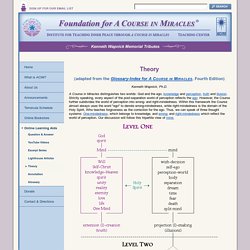
A Course in Miracles distinguishes two worlds: God and the ego, knowledge and perception, truth and illusion. Strictly speaking, every aspect of the post-separation world of perception reflects the ego. However, the Course further subdivides the world of perception into wrong- and right-mindedness. Within this framework the Course almost always uses the word "ego" to denote wrong-mindedness, while right-mindedness is the domain of the Holy Spirit, Who teaches forgiveness as the correction for the ego.
Thus, we can speak of three thought systems: One-mindedness, which belongs to knowledge, and wrong- and right-mindedness which reflect the world of perception. The accompanying chart summarizes the Course's description of the mind. T-1.V.5 T-3.IV.2-6 T-4.I.2-3 T-7.IX.1-4 W-pI.96.3-5 C-1. A Course in Miracles Text Made Simple. A Course in Miracles Manual For Teachers. A Course in Miracles Manual For Teachers 10.
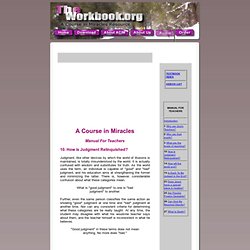
How is Judgment Relinquished? Judgment, like other devices by which the world of illusions is maintained, is totally misunderstood by the world. It is actually confused with wisdom and substitutes for truth. What is "good judgment" to one is "bad judgment" to another. Further, even the same person classifies the same action as showing "good" judgment at one time and "bad" judgment at another time. "Good judgment" in these terms does not mean anything. It is necessary for the teacher of God to realize not that he should not judge, but that he cannot. Recognizing that judgment was always impossible for him, he no longer attempts it. Timothy Conway. This Timothy Conway fellow is a story within a dream… A mere, mortal figment pointing you back to the immortal Divine Dreamer, Your Real Self, the One Who Alone IS.
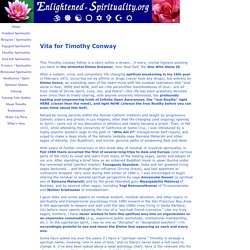
After a sudden, vivid, and completely life-changing spiritual awakening in my 16th year in February 1971, occurring not by efforts or drugs (never took any drugs), but entirely by Divine Grace, an exploding open of the heart-mind with the nondual realization that “God alone is Real, HERE and NOW, and we—the personified manifestations of God— are all truly made of Divine Spirit, Love, Joy, and Peace”—this life has been gratefully devoted ever since then to freely sharing, with anyone sincerely interested, the profoundly healing and empowering truth of Infinite Open Awareness, the “real Reality” right HERE (closer than the mind), and right NOW (always the true Reality before you can even think about this Self). Some have asked me over the years if i have a “spiritual name.”
Are you enjoying the dream, O Divine One? P.S. --c1989. A Course in Miracles/Manual for Teachers - Wikisource, the free online library. A Course in Miracles Workbook Lesson 13 Insights. To gain the most from A Course in Miracles Lesson Insights, we recommend that you read the corresponding lesson in the Workbook of the Second or Third Edition of A Course in Miracles published by the Foundation for Inner Peace.
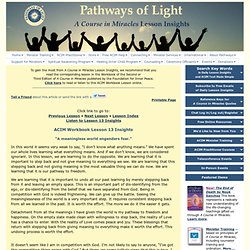
Click here to read or listen to this ACIM Workbook Lesson online. Tell a Friend about this article or send the link with a Printable Page Click link to go to: Previous Lesson • Next Lesson • Lesson IndexListen to Lesson 13 Insights ACIM Workbook Lesson 13 Insights “A meaningless world engenders fear.” In this world it seems very weak to say, “I don’t know what anything means.” We are learning that it is important to undo all our past learning by merely stepping back from it and leaving an empty space.
Detachment from all the meanings I have given the world is my pathway to freedom and happiness. It doesn’t seem like I am in competition with God. Here it is most clear that I am in competition with God. Lesson. I have given everything I see in this room [on this street, from this window, in this place] all the meaning that it has for me.
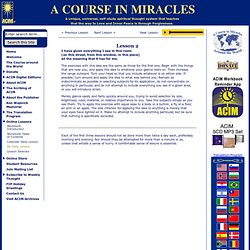
The exercises with this idea are the same as those for the first one. Begin with the things that are near you, and apply the idea to whatever your glance rests on. Then increase the range outward. Turn your head so that you include whatever is on either side. If possible, turn around and apply the idea to what was behind you. Merely glance easily and fairly quickly around you, trying to avoid selection by size, brightness, color, material, or relative importance to you. Each of the first three lessons should not be done more than twice a day each, preferably morning and evening.